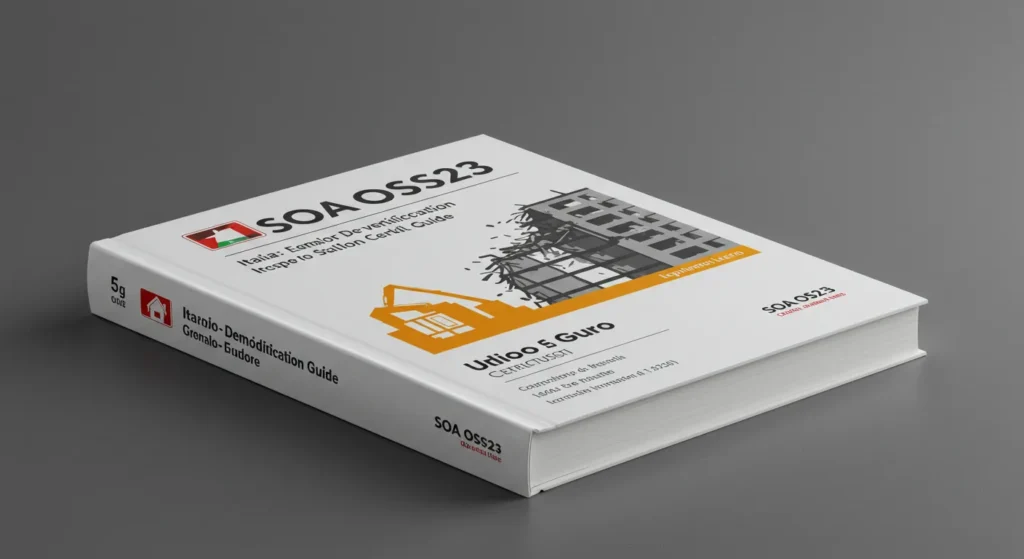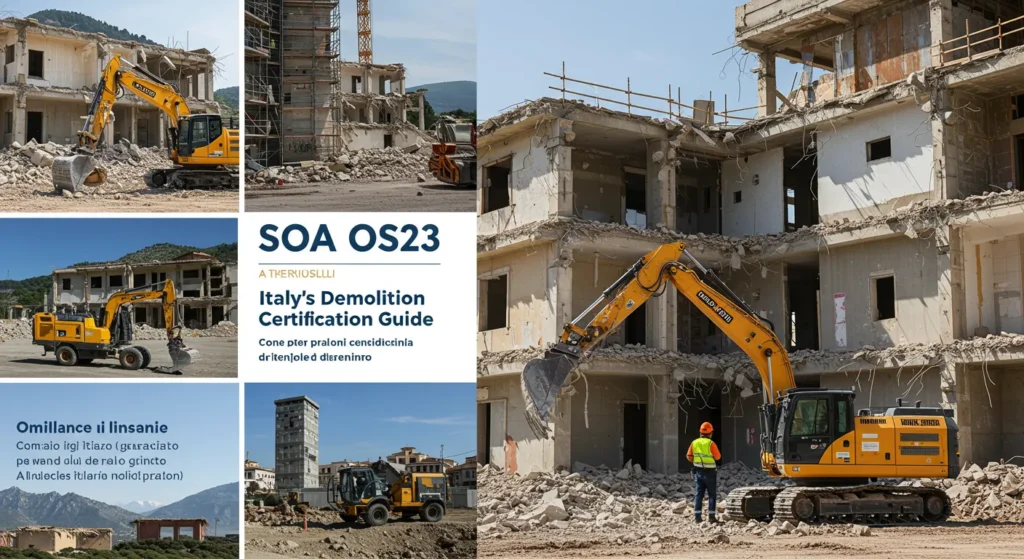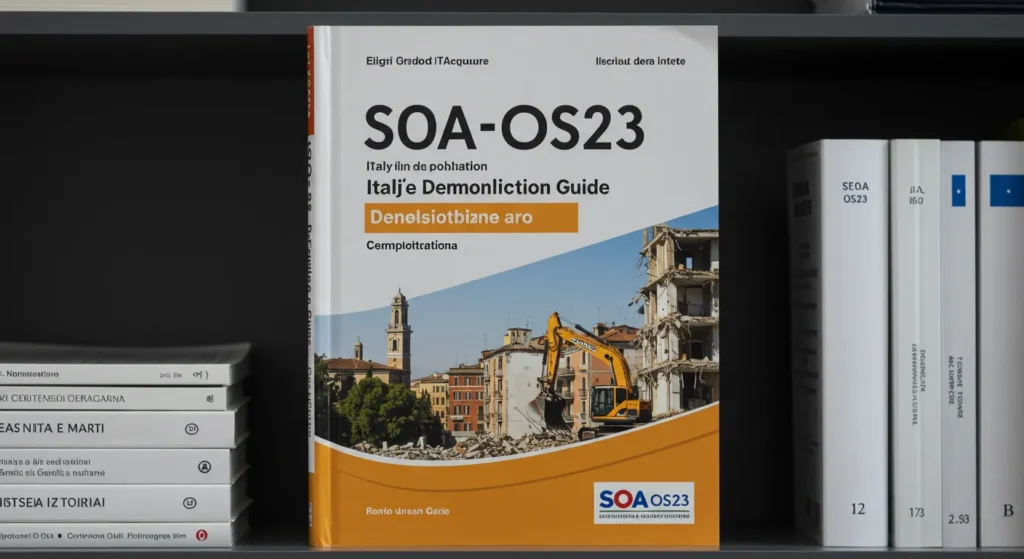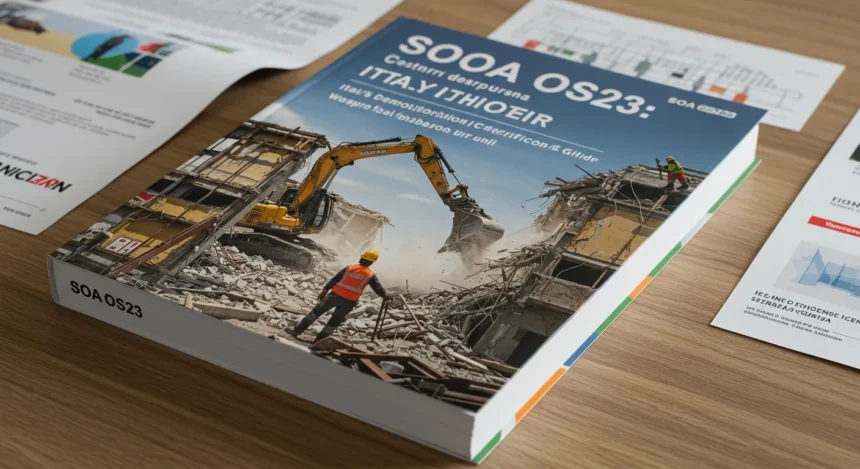Table of Contents
We understand the complexities of navigating certifications in Italy’s construction sector. SOA OS23 stands out as a vital qualification for companies aiming to secure public demolition contracts. This guide dives deep into the certification, offering a clear roadmap for compliance, benefits, and future trends in 2025.
Italy’s public works demand precision, safety, and adherence to strict regulations. The certification ensures companies meet these standards for demolition projects. From sustainable practices to digital tools, we cover everything you need to know to stay competitive.
What Is SOA OS23 Certification?

The SOA OS23 certification qualifies companies for public demolition projects in Italy. Governed by Annex A of the Italian Presidential Decree 207/2010, it verifies a company’s technical and financial ability to handle complex demolition tasks. While not always mandatory, it’s a key credential for contracts exceeding €150,000.
This certification covers specialized demolition activities. It ensures firms can manage high-stakes projects with safety and efficiency. Companies with gain a competitive edge in public tenders.
Scope of Certification
The SOA OS23 certification applies to a range of demolition activities. It includes advanced techniques and sustainable practices. Here’s what it covers:
- Structural demolition of buildings and infrastructure.
- Controlled dismantling using diamond wire cutting or high-pressure water jets.
- Explosive-based demolition under strict regulations.
- Material separation and waste recycling for eco-friendly practices.
- Debris removal and transport for site clearance.
These tasks demand precision and compliance with Italy’s rigorous standards. The certification proves a company’s capability to deliver.
Why SOA Matters in 2025
The SOA OS23 certification is increasingly critical as Italy pushes for infrastructure upgrades and sustainability. It signals credibility and expertise to government clients. Without it, firms risk losing out on lucrative public contracts.
Certified companies demonstrate adherence to safety and environmental standards. This builds trust with clients and regulators. In 2025, the certification also aligns with green demolition trends, enhancing a firm’s reputation.
Benefits of Certification
Pursuing SOA OS23 offers tangible advantages. It streamlines operations and boosts marketability. Key benefits include:
- Competitive Advantage: Certified firms stand out in public tenders, securing more contracts.
- Improved Safety: Structured processes reduce on-site accidents and ensure compliance.
- Client Trust: Certification assures clients of quality and professionalism.
- Efficiency Gains: Certified methods lead to faster project completion and cost savings.
- Sustainability: Promotes eco-friendly practices like material recycling.
These benefits translate to better project outcomes and long-term success.
How to Obtain Certification

Securing the SOA OS23 certification requires a clear process. Companies must work with an authorized SOA body to verify their qualifications. The steps are straightforward but demand thorough preparation.
First, gather documentation proving legal standing, technical capacity, and financial stability. Submit these to the SOA body for review. A technical audit, including site visits and equipment checks, follows.
Step-by-Step Certification Process
Here’s a breakdown of the SOA OS23 certification process:
- Contact an SOA Body: Choose an authorized Società Organismo di Attestazione.
- Prepare Documentation: Provide evidence of compliance history, staff qualifications, and financial health.
- Undergo Technical Audit: Allow site inspections to verify equipment and safety protocols.
- Pass the Evaluation: Meet all technical and legal requirements to receive certification.
- Maintain Compliance: Agree to annual reviews to keep the certification active.
Failure to meet standards can lead to delays or rejection. Partnering with consultants can simplify the process.
Challenges in Securing
Obtaining SOA OS23 isn’t without hurdles. The process demands time and resources. Common challenges include:
- Documentation: Compiling detailed records is time-consuming.
- Training: Staff must understand certification standards, requiring investment.
- Audits: Ongoing reviews ensure compliance but add operational strain.
- Equipment Upgrades: Meeting safety and tech standards may require costly updates.
- Renewals: Tracking certification renewals prevents disruptions.
Addressing these challenges proactively ensures a smoother certification journey.
Certification Requirements
To qualify for SOA OS23, companies need specific capabilities. These include technical expertise and financial stability. Requirements focus on ensuring safe and efficient demolition work.
Applicants must show experience in demolition projects and provide proof of qualified staff. Financial records must demonstrate stability to handle large-scale contracts. Equipment must meet modern safety and technological standards.
Key Requirements Table
| Requirement | Details |
|---|---|
| Legal Standing | Proof of compliance with Italian laws and regulations. |
| Technical Capacity | Qualified staff and modern demolition equipment. |
| Financial Stability | Evidence of financial health to manage public contracts. |
| Safety Protocols | Adherence to strict safety and environmental standards. |
| Work Experience | Demonstrated history of successful demolition projects. |
Meeting these requirements positions companies for success in public tenders.
Future Trends in 2025
The SOA OS23 certification evolves with industry demands. In 2025, sustainability and technology shape its future. Companies must adapt to stay compliant and competitive.
Green demolition practices, like recycling aggregates, are now critical. Digital tools, such as BIM and GIS, streamline planning and approvals. AI and automation also enhance safety and efficiency.
Emerging Trends to Watch
Key trends for SOA OS23 in 2025 include:
- Green Demolition: Emphasis on recycling and low-emission equipment.
- Digital Tools: BIM for precise modeling and GIS for real-time environmental analysis.
- AI Integration: Predictive maintenance and automated processes boost efficiency.
- Digital Credentialing: Online portals simplify certification submissions and updates.
These trends align with Italy’s focus on sustainable infrastructure development.
Technology: A Dual Meaning

Beyond demolition, SOA OS23 refers to a Service-Oriented Architecture framework, notably OpenStack 2023. This technology streamlines cloud infrastructure and digital operations. It’s a modern solution for businesses seeking scalability and security.
This framework supports modular, cloud-native designs. It integrates with platforms like AWS and Azure, offering flexibility. Its features include advanced encryption, AI-driven automation, and real-time monitoring.
Key Features in Technology
The technology version of SOA OS23 offers powerful tools:
- Interoperability: Connects cloud and on-premise applications seamlessly.
- Security: Zero-trust policies and AES256 encryption ensure safety.
- Scalability: Adapts to growing workloads without performance loss.
- Automation: AI-driven tools reduce manual tasks and optimize workflows.
- Modular Design: Independent services enhance resilience and updates.
These features make it ideal for industries like finance, healthcare, and IoT.
Real-World Applications
The SOA OS23 framework supports diverse sectors:
- Finance: Secures transactions and ensures compliance with KYC regulations.
- Healthcare: Integrates patient records and telemedicine platforms.
- IoT: Manages device communication and updates efficiently.
- E-commerce: Enhances customer data privacy across platforms.
- Manufacturing: Optimizes data processing for smart factories.
These applications highlight its versatility beyond demolition.
Overcoming Challenges in Adoption
Both demolition and tech versions of SOA OS23 face challenges. In construction, documentation and training are hurdles. In technology, implementation costs and compatibility issues arise.
For demolition, thorough planning and consultant support ease certification. In tech, gradual adoption and training mitigate costs. Both require ongoing updates to maintain compliance.
Final Thoughts
The SOA OS23 certification is a cornerstone for demolition companies in Italy’s public sector. It ensures compliance, safety, and competitiveness in 2025’s evolving landscape. Adopting its principles positions firms for success in both construction and technology.
The dual meaning of highlights its versatility. Whether navigating public tenders or building scalable cloud systems, it drives efficiency and trust. Embrace to stay ahead in your industry.
FAQs
What is SOA OS23 certification?
SOA OS23 certification qualifies companies for public demolition contracts in Italy, ensuring technical and financial capability.
Is SOA OS23 mandatory for all demolition projects?
No, but it’s often required for public contracts over €150,000 to ensure safety and professionalism.
3. How long does it take to get SOA OS23 certified?
The process typically takes 3-6 months, depending on documentation and audit completion.
What are the costs of SOA OS23 certification?
Costs vary based on company size and consultant fees, often ranging from €5,000 to €20,000.
How does SOA OS23 apply to technology?
In tech, SOA OS23 refers to a cloud framework like OpenStack 2023, enhancing scalability and security.










